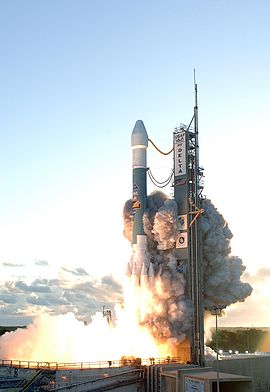Delta II

A Delta II rocket launches from Cape Canaveral carrying the Dawn spacecraft.
|
|
| Function | Launch vehicle |
|---|---|
| Manufacturer | United Launch Alliance (Boeing IDS) |
| Country of origin | United States |
| Cost per launch | US$51 million in 1987 (7920-10 mod.) |
| Size | |
| Height | 38.2–39 m (125–128 ft) |
| Diameter | 2.44 m (8 ft 0 in) |
| Mass | 151,700–231,870 kg (334,440–511,190 lb) |
| Stages | 2 or 3 |
| Capacity | |
| Payload to LEO | 2,700–6,100 kg (6,000–13,400 lb) |
| Payload to GTO | 900–2,170 kg (1,980–4,780 lb) |
| Payload to HCO | 1,000 kg (2,200 lb) |
| Launch history | |
| Status |
|
| Launch sites |
Cape Canaveral SLC-17 Vandenberg AFB SLC-2W |
| Total launches | 153 Delta 6000: 17 Delta 7000: 130 Delta 7000H: 6 |
| Successes | 151 Delta 6000: 17 Delta 7000: 128 Delta 7000H: 6 |
| Failures | 1 (Delta 7000) |
| Partial failures | 1 (Delta 7000) |
| First flight |
|
| Last flight | |
| Boosters (6000 Series) - Castor 4A | |
| No. boosters | 9 |
| Motor | Solid |
| Thrust | 478 kN (107,000 lbf) |
| Specific impulse | 266 s |
| Burn time | 56 s |
| Fuel | HTPB |
| Boosters (7000 Series) - GEM 40 | |
| No. boosters | 3, 4, or 9 |
| Motor | Solid |
| Thrust | 492.9 kN (110,800 lbf) |
| Specific impulse | 274 s |
| Burn time | 64 s |
| Fuel | HTPB |
| Boosters (7000 Heavy) - GEM 46 | |
| No. boosters | 9 |
| Motor | Solid |
| Thrust | 628.3 kN (141,200 lbf) |
| Specific impulse | 278 s |
| Burn time | 75 s |
| Fuel | HTPB |
| First stage - Thor/Delta XLT(-C) | |
| Engines | 1 RS-27 (6000 series) or RS-27A (7000 series) |
| Thrust | 1,054 kN (237,000 lbf) |
| Specific impulse | 302 s |
| Burn time | 265 s |
| Fuel | RP-1/LOX |
| Second stage - Delta K | |
| Engines | 1 AJ10-118K |
| Thrust | 43.6 kN (9,800 lbf) |
| Specific impulse | 319 s |
| Burn time | 431 s |
| Fuel | Dinitrogen tetroxide/Aerozine |
| Third stage - PAM-D (optional) | |
| Motor | Star 48B |
| Thrust | 66 kN (15,000 lbf) |
| Specific impulse | 286 s |
| Burn time | 87 s |
| Fuel | HTPB |
Delta II is an American space launch system, originally designed and built by McDonnell Douglas. Delta II is part of the Delta rocket family and entered service in 1989. Delta II vehicles included the Delta 6000, and two Delta 7000 variants ("Light" and "Heavy").
In the early 1980s, all United States expendable launch vehicles were planned to be phased out in favor of the Space Shuttle, which would be responsible for all government and commercial launches. Production of Delta, Atlas-Centaur, and Titan 34D had ended. The Challenger disaster of 1986 and the subsequent halt of Shuttle operations changed this policy, and President Ronald Reagan announced in December of that year that the Space Shuttle would no longer launch commercial payloads, and NASA would seek to purchase launches on expendable vehicles for missions that did not require crew or Shuttle support.McDonnell Douglas, at that time the manufacturer of the Delta family, signed a contract with the U.S. Air Force in 1987 to provide seven Delta IIs. These were intended to launch a series of GPS Block II satellites, which had previously been manifested for the Space Shuttle. The Air Force exercised additional contract options in 1988, expanding this order to 20 vehicles, and NASA purchased its first Delta IIs in 1990 for the launch of three Earth-observing satellites. The first Delta II launch occurred in 1989, with a Delta 6925 boosting the first GPS Block II satellite into a 20,000 km high orbit.
The first Delta II 7000-series flew in 1990, replacing the RS-27 engine of the 6000-series with the more powerful RS-27A. Additionally, the steel-cased Castor 4A solid boosters of the 6000 series were replaced with the composite-cased GEM 40. All further Delta II launches except three were of this upgraded configuration, and the 6000-series was retired in 1992.
...
Wikipedia
